



They developed a working prototype based on an iPad Touch tablet display that can compensate for individual vision problems. This isn't the first project that attempted to use computer screens to correct vision problems, but offers “significantly higher contrast and resolution compared to previous solutions”. The team hopes this technology can be adapted into a screen protector that could be added to any existing device, allowing the software to be modified for different operating systems. Hopefully we will see it on Kindles and other tablets one day. Eye-tracking tech would need some improvement in order for the displays to keep track of the user's head and be able to adapt to its movements. The prototype will be presented at the International Conference and Exhibition on Computer Graphics and Interactive Techniques in Vancouver on August 12.

 Laptop & Tablet Parts
Laptop & Tablet Parts




















